Popularly known as Archimedes Death Ray or Archimedes Heat Ray, this invention has an ancient legend and a modern cult following. Archimedes (c. 287 – 212 BC) was a “renaissance man” before his time; by this I mean that he was mathematician, physicist, engineer, astronomer and inventor. His inventions were so renown that fifteen-hundred years later true Renaissance man Leonardo Da Vinci diagramed one of Archimedes’ mythic inventions; the steam cannon. Today many people still challenge that the harnessing of solar energy as military fire power could have been a reality around 200 BC. The legend has it that Archimedes had an invention that he used in battle against Roman naval forces; an invention that could set ships afire as they approached the coast of Syracuse in Sicily. Johannes Tzetzes (1110 – 1180) wrote that Archimedes used a group of mirrors orchestrated by mechanics to alter focal length. Lucian (c. 125 AD – 180 AD) wrote that Archimedes constructed a “burning glass” to ignite Roman war ships. The mirror theory is the one that has been continually debunked and the burning glass theory is the one that is outright dismissed because it sounds too much like a lense – something that wouldn’t be in use with quality optics until the mid thirteenth century. In this post, I’m going to share with you how both theories are actually plausible because all of the trials attempting and failing to prove them were missing a key factor. I promise to reveal the missing ingredient later in this post.
Before I get into details, let me start by making it clear that I am not a historian or a scientist. I’ll do my best to explain what I know and discovered using words and terms that make sense to me and I think to most other lay people. So please forgive me if I don’t quite get my definitions precise or some of my math or dates aren’t scholarly. This is not meant to be scholarly, just a bit edu-taining.
First, let’s evaluate the historicity of the tale of the Archimedes Solar Ray. None of Archimedes own writings are known to exist and very few copies of Archimedes’ texts by his contemporaries are extant, none of which contain any mention of a solar or heat ray invention. However there are writings by other ancient authors who reported that Archimedes did have and use such tools against the Roman fleet. These authors include: Diodorus Siculus (Greek c. 90 – 30 BC), Lucian (Syrian c. 125 AD – after 180 AD), Galen (Greek 129 – 210 AD), Dion Cassius (Greek 155 – 235 AD), and Pappus (Greek 290 – 350). But most people today have become familiar with the legend from the History Channel’s features on ancient subjects, and from Mythbusters’ three rounds of busted rulings. In these televised entertainment shows, visuals being an integral part of good entertainment, a few paintings of the legend are often shown. But these are so far removed from the purported event as to be useless examples. There are several; the most popular are by Giulio Parigi (1571–1635), and another by Cherubino Cornienti (1816 -1860). There’s also a few etchings, the most popular is probably by Athanasius Kircher (1602-1680). So what’s depicted in these renderings are just the creative imaginations of the artists and they don’t impart any factual data at all. We are much better sticking with the early written accounts from Diodorus and Lucian. At least in their cases there is a higher probability of a surviving verbal legend because the accounts are within five or six generations of the alleged event. Even so, there is very little to be gleaned; only that, if it’s factual, Archimedes might have used a mirror or Archimedes might have used a burning glass and that there was some kind of apparatus for aiming or focusing the beam. The story of the distance between ship and shore as being a bow shot away, was told in the twelfth century by Tzetzes, drawing on Cassius Dio and Diodorus Secundo, and was accepted as part of the Mythbusters challenge criteria.
The problem in believing the stories, is that no one has been able to prove it to be possible with the technology of Archimedes’ day. Sure, we can demonstrate that a parabolic mirror (1600’s) or a lense like a solid magnifying glass of sufficient clarity (1250) can effectively imitate the legend at very close range but neither parabolic mirrors nor large magnifying lenses of solid glass where invented anywhere near 200 BC. I should acknowledge that there were small magnifying lenses made of glass or crystal as this abstract in the American Journal of Archaeology – Lenses in Antiquity explains. When I say small, they were impractical for use as burning tools at medium distance to a ship because they were less than half an inch in diameter and the optics were not good at all. All that this means is that lenses were renown throughout the middle east in the bronze age and that’s a minimum of a thousand years before Archimedes was born. Six hundred years later there is a written account by Aristophanes in his play The Clouds (424 BC) of a good quality lense, probably a crystal, “the beautiful transparent stone with which they light fires.” So now that’s only 200 years before Archimedes but it’s still just a small object used at close range. What we can take away from these facts is that the expectation that the making of transparent glass would only get better, and that is important to my argument since it’s good quality, highly transparent glass that matters to my hypothesis, not crystal and not its traditional use in close range fire starting.
So how could Archimedes have made a lense similar to our modern lenses almost two millennia before their modern advent? The answer is that he couldn’t, but he could have made a different kind of lense that is also very effective. He could have made a lense out of glass and water and I can prove that Archimedes had the knowledge and resources to do it. Although there’s no explicit reference to lenses or burning rays in the extant copies of Archimedes writings, the same does reveal that Archimedes had a clear understanding of three of the necessary principles of refraction (see Atmospheric Refraction: A History pg. 2) specifically as they pertain to water: [1. Incident, refracted and normal rays lie on the same plane. 2. Submerged points appear at a straight line to the eye. 3. The angle of incidence is always greater than the angle of refraction respective of the medium density]. It is the opinion of Belgian scholar Albert Lejeune, author of Greek catoptric research from ancient sources, that Archimedes understood the fourth principle as well [the actual location of a submerged object is on a line through the refracted image and is perpendicular to the surface of the medium]. Furthermore, within 300 years after Archimedes, Pliny the Elder (23-79 AD) and Seneca the Younger (3 BC – 65 AD) described how glass balls filled with water could set clothes on fire. For our purposes, it is important to recognize that Archimedes understood that water bends light, and he knew the angle of that bend with specific precision.
I think that Archimedes knew that crystal optics were not scalable to a large enough size to be practical for starting fires. I also think that it is perfectly reasonable that Archimedes could have used a large curved glass vase of sorts to contain water, and that the water acted as a lense. Let me be clear; it’s the combination of plain glass as a container and water together that form the lense. Glass is just a transparent medium to contain and shape water. It is water that does the refracting, and we just demonstrated that Archimedes knew this concept extremely well.
So now the question has shifted from “how could Archimedes have made a lense?” to “how good of a lense could Archimedes make?”. The lense would only be as good as the glass was transparent. It just so happens that the second century BC saw a boon in translucent or transparent glass production, according to a Wiki post on Hellenistic Glass (emphasis below is mine):
“Within the production of these drinking vessels, from the mid-2nd century BC onwards, translucent or transparent glass tableware (plates, dishes, bowls, drinking vessels, such as skyphoi, footed bowls or handled cups) was introduced; glass tableware production once established enjoyed several glassworking centres and contributed in the dramatic increase of the Hellenistic glass industry. This was the first time that glass vessels were widely consumed by the broader public as a widespread commodity, something that continued ever since and was achieved in a higher degree with the invention of the even more economical glassblowing technique.”
This particular wikipedia post is well annotated especially with regard to this source: Five Thousands Years of Glass, hugh Tait. On page 47 of this book that you can search on Amazon, there is a photo of an, “almost colourless” bowl that is said to have originated in Cumae, Southern Italy, which is about seven-hundred miles North of Syracuse Italy where Archimedes lived (Both Cumae and Syracuse are port cities). This particular bowl is important to my argument as it is proof that clear, nearly transparent glass existed outside the Persian Empire, and indeed, in Southern Italy with approximation to Archimedes, prior to the second century BC. This now means that if a lense made of clear glass and water can be demonstrated today to be effective enough to set wood on fire at medium to close range, then it would have been possible for Archimedes to do the same.
So now it remains to demonstrate the effectiveness of the water lense described above. Take a look at this camping hack made from a piece of clear vinyl. Green Power Science (Dan Rojas) reports making a water lense with 1/3 Kilowatts heat power, enough to burn wood. There are many more videos like this on YouTube, just search “water Lense“.
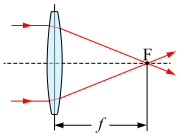 But the focal length still remains a problem, because even on a ten foot water lens the focal point would not be anywhere near the length of a second century BC Roman bowshot , which could be anywhere from two-hundred to six-hundred feet. What is a focal point? The focal point (f in the diagram to the right) is the axis where light rays converge. It’s the place where rays are most concentrated. Beyond the focal point light rays begin diverging again. A burning device is useful only at this apex, which is why tests with these kinds of lenses made of glass/crystal always fail; because everyone stops here instead of finding a way to bend the diverging rays into a beam – And there are ways to stop the rays from diverging; that is, there are legitimate ways to force the rays to run parallel in a beam.
But the focal length still remains a problem, because even on a ten foot water lens the focal point would not be anywhere near the length of a second century BC Roman bowshot , which could be anywhere from two-hundred to six-hundred feet. What is a focal point? The focal point (f in the diagram to the right) is the axis where light rays converge. It’s the place where rays are most concentrated. Beyond the focal point light rays begin diverging again. A burning device is useful only at this apex, which is why tests with these kinds of lenses made of glass/crystal always fail; because everyone stops here instead of finding a way to bend the diverging rays into a beam – And there are ways to stop the rays from diverging; that is, there are legitimate ways to force the rays to run parallel in a beam.
Now we have finally come to the point that I promised you I would share. We are at the point where I’m going to tell you what key factor all trials of the modern models of the Archimedes ray has missed. As any physicist will confirm, the missing article is a collimator. A collimator is a device that directs converging/diverging rays of light into a closely parallel direction. Collimation is what magically happens in Star Wars when the Death Star fires its death ray. All the beams of light converge into one beam and instead of crossing over each other, they point away from the Death Star. But in the Star Wars movies, there is no causality for this action; the rays just defy physics, maybe by the Force. In our real universe we need a device to cause light to bend and that device is called a collimator.
There are all kinds of collimators for all kinds of waves. For sunlight, the options are narrowed down into three categories: aperture collimators, lens collimators, and combination mirror/lense collimators. One example of an aperture (not a collimator) is the wonderful camera obscura; the light sealed room or large box with a single pinhole on one side where sunlight projects an inverted image of the outside scenery on the opposite wall. In order to get a beam of light (to collimate light) using aperture, we have to use two pinholes at opposite sides of a box – so basically another hole in the camera obscura at the side where the image appears (Herold York, research scientist in Pasadena CA explains in this video how to make a beam of light with pinhole apertures and describes its ineffectiveness as a beam for prism refraction). Instead of aiming the aperture at a subject, which is reflected sunlight, we aim it at the sun, which is relatively straight light. The dual apertures only allow the most parallel light in their path to pass through. We could also replace the second aperture with a lense, but because we are using at least one aperture, the end result is a beam of light with decreased brightness, which is counter productive since our goal is to concentrate sunlight rather than filter it.
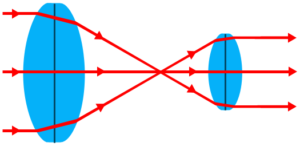 The second option is to use a pair of lenses (something Archimedes could have done). We can use a large bi-convex lense to bend light into converging lines, and then another smaller bi-convex lense to restore the rays into practically parallel rays again but at a smaller circumference. The result would be an intense, condensed or concentrated light that lay people such as myself would call a light beam or ray. A bi-convex lense bows out on two sides. As sunlight enters the outer curve of the first side it bends into converging paths. As light exits the far outer curve it bends again into a steeper converging path. The opposite happens when diverging paths of light enter a bi-convex; they bend into increasingly more parallel paths. Our goal would be to converge sunlight with the large bi-convex lens and then straighten it with the small bi-convex lense close to the apex of convergence, thereby concentrating the light beam as much as possible.
The second option is to use a pair of lenses (something Archimedes could have done). We can use a large bi-convex lense to bend light into converging lines, and then another smaller bi-convex lense to restore the rays into practically parallel rays again but at a smaller circumference. The result would be an intense, condensed or concentrated light that lay people such as myself would call a light beam or ray. A bi-convex lense bows out on two sides. As sunlight enters the outer curve of the first side it bends into converging paths. As light exits the far outer curve it bends again into a steeper converging path. The opposite happens when diverging paths of light enter a bi-convex; they bend into increasingly more parallel paths. Our goal would be to converge sunlight with the large bi-convex lens and then straighten it with the small bi-convex lense close to the apex of convergence, thereby concentrating the light beam as much as possible.
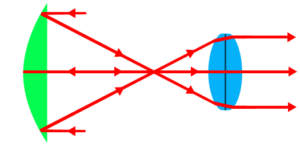 The third option is to use a parabolic mirror to replace the first bi-convex lens in the dual-lens solution above. A tempting reason to use a combination of parabolic mirror and glass lens is that it satisfies both sources of legend. But there are a couple of problems with involving a mirror. The first problem is that the available materials are purported to be ineffectively reflective. Most people, including Mythbusters, have insisted on using polished bronze/brass/copper as a reflective material sighting that bronze was a commonly used metal during the Hellenistic period. But the reflectivity of bronze (70 – 75%) is lower than the mirrors we use today (90 – 95%). So why not use silver or aluminum as the reflectivity of silver (88 – 93%) or aluminum (90%) are 10 to 20 percent higher than bronze and are most commensurate with our modern mirrors (modern mirrors use silver and or aluminum)?
The third option is to use a parabolic mirror to replace the first bi-convex lens in the dual-lens solution above. A tempting reason to use a combination of parabolic mirror and glass lens is that it satisfies both sources of legend. But there are a couple of problems with involving a mirror. The first problem is that the available materials are purported to be ineffectively reflective. Most people, including Mythbusters, have insisted on using polished bronze/brass/copper as a reflective material sighting that bronze was a commonly used metal during the Hellenistic period. But the reflectivity of bronze (70 – 75%) is lower than the mirrors we use today (90 – 95%). So why not use silver or aluminum as the reflectivity of silver (88 – 93%) or aluminum (90%) are 10 to 20 percent higher than bronze and are most commensurate with our modern mirrors (modern mirrors use silver and or aluminum)? 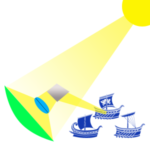 Both silver and aluminum were used in Greece during Archimedes lifetime. Silver may have been a more costly metal but considering that Syracuse was such a renown capital at the time I think they had the resources and would have spared the expense in order to fight back the Romans, who would certainly pliage their metals no matter if they were bronze, silver or aluminum, which could explain why Archimedes’ device did not survive. The second problem is that Syracuse faced east into the ocean, requiring more mirrors to direct the rays if the attack occurs at any other time than morning. But it’s still not a compelling argument since all you have to do is point the mirror and lense at the sun and then use small mirrors to direct the resulting beam.
Both silver and aluminum were used in Greece during Archimedes lifetime. Silver may have been a more costly metal but considering that Syracuse was such a renown capital at the time I think they had the resources and would have spared the expense in order to fight back the Romans, who would certainly pliage their metals no matter if they were bronze, silver or aluminum, which could explain why Archimedes’ device did not survive. The second problem is that Syracuse faced east into the ocean, requiring more mirrors to direct the rays if the attack occurs at any other time than morning. But it’s still not a compelling argument since all you have to do is point the mirror and lense at the sun and then use small mirrors to direct the resulting beam.
How do my designs differ from the failed attempts on Mythbusters? To answer that question let’s take a look at the reasons given by the Mythbusters crew on episode 46 for busting the myth. I’m using a transcribed version of Mythbusters Episode 46 and I’ve written my response in bold after each:
- Compass: Syracuse faced east into the ocean, so Archimedes would have had to use morning rays for his weapon.
- Response – It’s a simple solution to use mirrors to direct the sunlight at nearly all daylight hours. If we use the dual water lense option then the light passes through a good angle and the objection is moot.
- Weather: mirrors only work when the sun is out.
- Response – True, but it doesn’t mean that it wasn’t shining on some of the days in the three-year war between 215 and 212 BC. The device(s) could have been used some of the time. Rainfall occurs mostly in winter between October and April, which leaves five months where rain is scarce. Even during winter average annual rainfall is 16.4 inches, which is less than southern California. As a Southern Californian, I can testify that its mostly sunny here year ’round, making this objection truly minor.
- Roman boats were moving: the death ray would have had to work quickly.
- The use of a collimator greatly increases the intensity of the heat ray and speeds up ignition. The beam would increase in intensity as the ships get closer. A post at MIT’s blog about MIT’s experiments of their mirror version of Archimedes Death Ray, describes the Roman ships as “anchored within bow and arrow range”.
- ‘Inflammable’ sails: sails are difficult to ignite because of their light color and flapping.
- We don’t need to ignite sails, the beam from my design is sufficient to ignite wood.
- History: It wasn’t until 800 years after the battle was that history books mentioned the use of mirrors.
- We can use the model without mirrors. Mirrors were mentioned by Lucian (125-180 AD) and Galen (129 – 210 AD) so it’s more like 400 years (50% better than claimed).
- Scale: It would take quite a lot of people and mirrors to ignite a boat quickly.
- Since my new models using water lenses are more effective it takes fewer people. According to Britannic the Syracusan garrison numbered 5000, which is overkill for this design.
- Alternatives: flaming arrows and fireballs are much easier to create, fire, and aim and also use much less manpower.
- This is the best argument so far and fits with the notion that the accounts of Archimedes death ray were nothing more than anti-Roman propaganda, considering that most of the early accounts of the ray weapon are of Greek origin and at least one of them is written by a Greek patriotic satirist. However, this merely amounts to cause for doubt and doesn’t absolutely negate the possibility that the Greeks had multiple weapons at their disposal including a sometimes employed death ray of Archimedes design.
- Equal doubt is cast by historians and scientists on the account of Archimedes having determined the composition of king Hiero II’s crown by water displacement AKA the Archimedes Principle of buoyancy (Vitruvius, Roman 1st century BC). Galileo debunked this myth and proposed another method that Archimedes might have used. The principle explained by Galileo remains a scientific truth and is nonetheless attributed to Archimedes. Likewise, I am suggesting a different method of creating a ray based on scientific principles that I have demonstrated Archimedes understood and which may be attributed to Archimedes in the same manner.
Soon I will build a small scale heat ray out of a set of glass cookware lids. I plan to record a field test and post it to YouTube. I’ll update this post with a link once the test is completed. It’s too bad that Mythbusters isn’t still actively in production, otherwise I would challenge them to make large scale versions of my hypothesis and field test, so as to more fully test the veracity of my claim to having solved the Archimedes Heat Ray Mystery.
Resources:
Tatton-Brown, V. and Andrews, C., 2004. Before the Invention of Glassblowing. In: Tait, H. (ed), Five Thousands Years of Glass (revised edition). London: British Museum Press, 21-61.
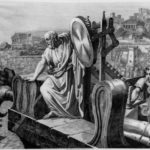
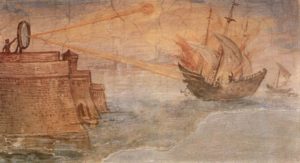
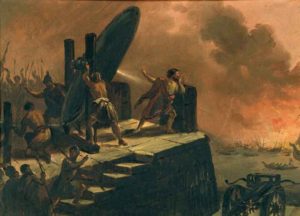
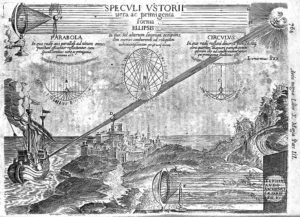
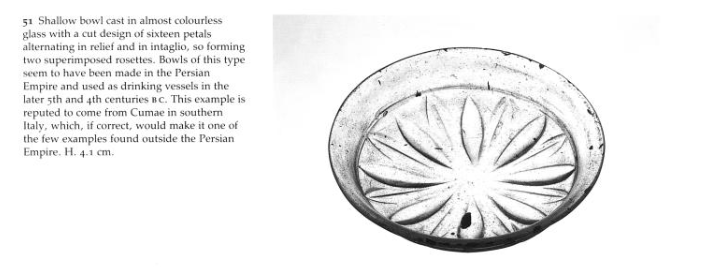
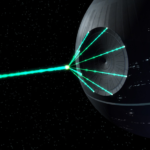
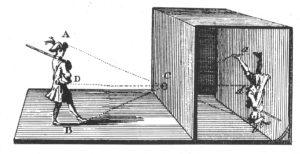
Leave a Reply